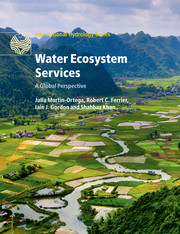Book contents
- Frontmatter
- Contents
- List of contributors
- Preface
- 1 Introduction
- 2 What defines ecosystem services-based approaches?
- Part I Addressing global challenges
- Part II Applying frameworks for water management and biodiversity conservation under an ecosystem services-based approach
- Part III Assessing water ecosystem services
- 9 The first United Kingdom's National Ecosystem Assessment and beyond
- 10 Using an ecosystem services-based approach to measure the benefits of reducing diversions of freshwater: a case study in the Murray-Darling basin, Australia
- 11 An ecosystem services-based approach to integrated regional catchment management: the South East Queensland experience
- 12 Policy support systems for the development of benefit-sharing mechanisms for water-related ecosystem services
- 13 Assessing biophysical and economic dimensions of societal value: an example for water ecosystem services in Madagascar
- 14 Rapid land use change impacts on coastal ecosystem services: a South Korean case study
- Part IV Broadening the perspective
- Index
- Plate Section
- References
9 - The first United Kingdom's National Ecosystem Assessment and beyond
from Part III - Assessing water ecosystem services
Published online by Cambridge University Press: 05 May 2015
- Frontmatter
- Contents
- List of contributors
- Preface
- 1 Introduction
- 2 What defines ecosystem services-based approaches?
- Part I Addressing global challenges
- Part II Applying frameworks for water management and biodiversity conservation under an ecosystem services-based approach
- Part III Assessing water ecosystem services
- 9 The first United Kingdom's National Ecosystem Assessment and beyond
- 10 Using an ecosystem services-based approach to measure the benefits of reducing diversions of freshwater: a case study in the Murray-Darling basin, Australia
- 11 An ecosystem services-based approach to integrated regional catchment management: the South East Queensland experience
- 12 Policy support systems for the development of benefit-sharing mechanisms for water-related ecosystem services
- 13 Assessing biophysical and economic dimensions of societal value: an example for water ecosystem services in Madagascar
- 14 Rapid land use change impacts on coastal ecosystem services: a South Korean case study
- Part IV Broadening the perspective
- Index
- Plate Section
- References
Summary
9.1 INTRODUCTION
As water and land resources become scarcer, further conflicting demands of different uses and users will arise (Vörösmarty et al. 2000). Sustainable management is required to secure water resources for future generations. Ecosystem services-based approaches aim to ensure that the values of a broad range of benefits to humanity that are provided by our natural environment are accounted for in policy making, in order to foster sustainable development (Chapter 2). National-level incorporation of sustainable development goals has propelled interest in large-scale assessments of ecosystem services which can help address complex problems of ecosystem change (Bateman et al. 2013).
The central question of this chapter is whether large-scale ecosystem services-based approaches provide an opportunity for improving water management. The UK National Ecosystem Assessment (UK-NEA) was the first analysis of the societal benefits of the UK natural environment (UK-NEA 2011a). Moreover, it was one of the leading initiatives worldwide to assess ecosystem services at national level after the Millennium Ecosystem Assessment (Millennium Ecosystem Assessment 2005) produced a global assessment. The first phase of the UK-NEA provided a wealth of policy-relevant information, and we use it here as a case study.
UK rivers, lakes, and ponds make up around 250 000 hectares (1.1%) of the UK total surface area. These surface waters, together with unseen groundwater systems, contribute significant ecosystem services and goods to human well-being in the UK. The quality of UK freshwaters has improved over the last 50 years following direct regulatory interventions in rural and agricultural practices and EU Directives, such as the Water Framework Directive (Watson 2012). These policies have led to a reduction of point and diffuse chemical pollution and improved ecological conditions. Nonetheless, pressures from agricultural, industrial, and domestic use on water resources remains high, both in terms of quality and quantity (Watson 2012). Agricultural practices and landscape modifications, such as use of fertilisers, habitat fragmentation, and degradation, reduce the ecosystem service provision and resulting human benefits.
- Type
- Chapter
- Information
- Water Ecosystem ServicesA Global Perspective, pp. 73 - 81Publisher: Cambridge University PressPrint publication year: 2015
References
- 1
- Cited by

